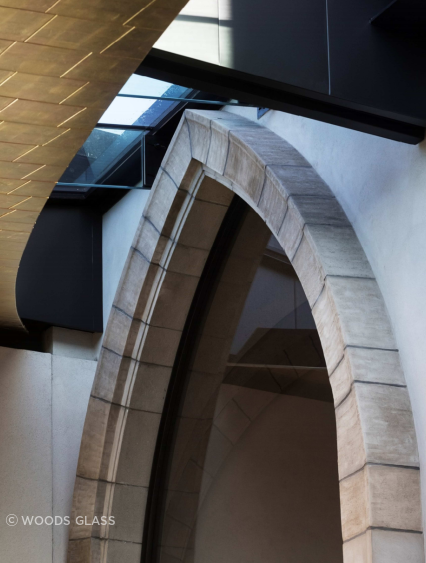The glassy, elegant new Bishop Selwyn Chapel brings together Parnell’s Holy Trinity Cathedral.
Sixty years isn’t an excessive period of time to take to complete a cathedral. Many in Europe have taken centuries. Even so, the wildly eclectic stop-start development of Parnell’s Holy Trinity Cathedral never seemed to suffer from an excess of speed. The foundation stone for the cathedral was laid in 1957 and the building – a scaled-down version of a pre-war Charles Towle design – completed in 1973. Almost a decade later, the beautiful timber St Mary’s-inHoly-Trinity, designed by Benjamin Mountfort in the late 1800s, was moved next to it. Then Richard Toy designed the cathedral’s dramatic, zigzagging nave in the early 1990s, but until very recently, things were terribly unresolved out the back. The cathedral’s southern wall was partially clad in patches of corrugated iron, awaiting a chapel to complete the ensemble.
That chapel arrived earlier this year, a glass box topped with a delicately draped golden ceiling that is the realisation of a competition-winning concept by Fearon Hay Architects. It allows visitors to look south through oak trees towards Maungawhau and Maungakiekie, to the west to St Mary’s, and behind to the chancel (the space around the altar). It adds an elegant note of cohesion to this diverse architectural group.
Here, Fearon Hay’s Jeff Fearon and Holy Trinity Cathedral Dean Jo Kelly-Moore talk through the chapel’s key features.
Embracing the view
The new chapel faces south onto the Trinity Garden, designed by Jacky Bowring, and to views of the volcanic cones beyond. Glass doors open the intimate 130-seat space fully to the view, enhanced by a gold ceiling that lifts at its perimeter to open up to the landscape. St Mary’s-in-Holy-Trinity, completed in 1886 and moved to its current site from across Parnell Road in 1982, is at left, and the chancel behind. “We wanted to create something that knitted the precinct of the cathedral together,” says Fearon.

Playing with light
“It’s almost like you’ve extended a plane of fabric and let it drape,” Fearon says of Bishop Selwyn Chapel’s striking ceiling, clad in three different shades of hand-applied gold leaf. Says Kelly-Moore: “At night it is exquisite – it’s an ever-changing feast”. At the rear is the wall of the original chancel.

The view south
Large motorised doors open the chapel completely to the view south, a key axis that connects the chapel with the chancel behind it. “We wanted it to feel like it was an extension of the original intentions of Bishop Selwyn, which was to lay the axis of the cathedral from the north all the way towards Maungakiekie in the south,” says Fearon. “We very quickly started thinking about an open form that used the existing garden, St Mary’s and the wider landscape of Auckland as the experience of the chapel.” In winter, the vista unfolds as the leaves fall from the oaks.

Creating an ensemble
“There are a lot of objects here,” says Fearon of the cathedral precinct, “and they are all quite purposely put together in an eclectic manner. We wanted to celebrate this eclecticism and the landscape – the open space and the built form – and we thought this glass building would bring it all together, rather than place another hard built element in the collection of buildings that was already there

Contemplation space
The chapel’s roof extends over terraces on its east (left) and west (right) sides that are extensions of the chancel ambulatories. Built-in benches are spaces for contemplation that are used throughout the day.

Melding old and new
The junction between the original chancel and the new chapel is handled with a mixture of delicacy and heft, with strong steel beams and glass junctions, and the gold ceiling swooping past the chancel exit. The glass ceiling panels allow dramatic views up the sheer, cliff-like wall of the chancel.

Visible welcome
Kelly-Moore says the glass walls of the Bishop Selwyn Chapel are a gesture of openness. “It’s very much in keeping with our philosophy at the cathedral,” she says. “We don’t want to be hidden away behind walls – we want that sense of people feeling welcome. And they do come and peer in and see what’s going on, which is exactly what we want. Come in and enjoy it!”
This article was first published in Paperboy magazine